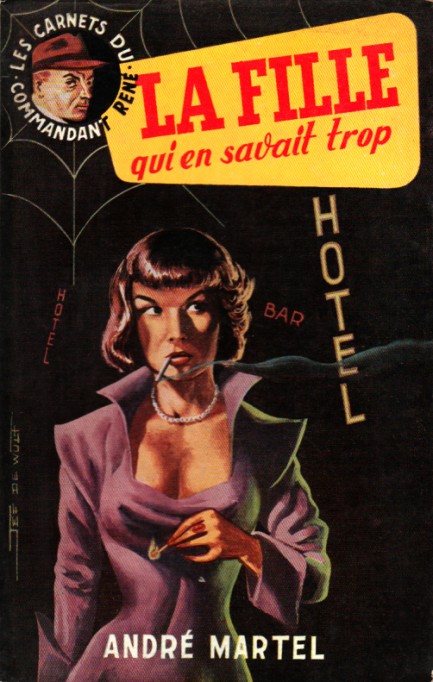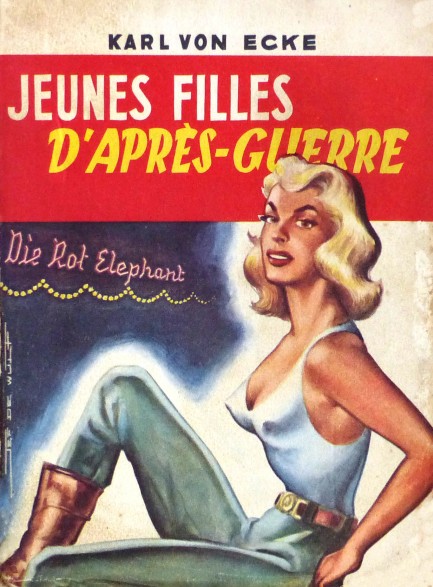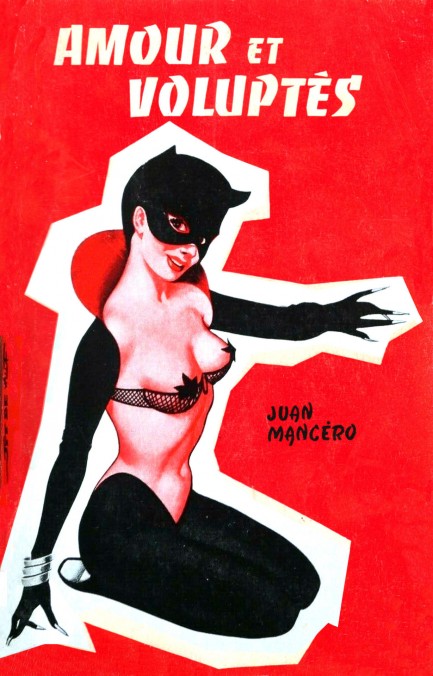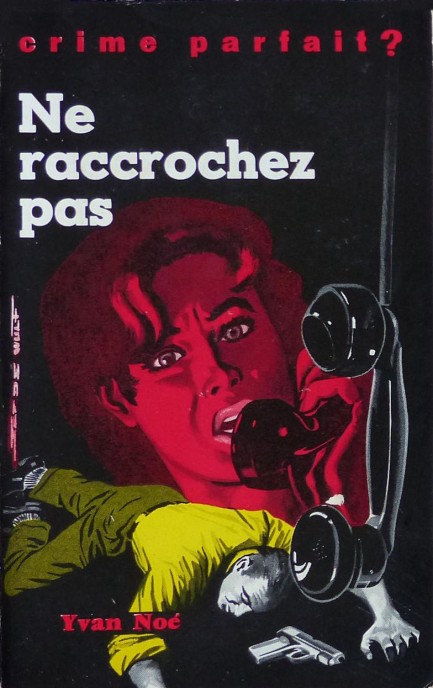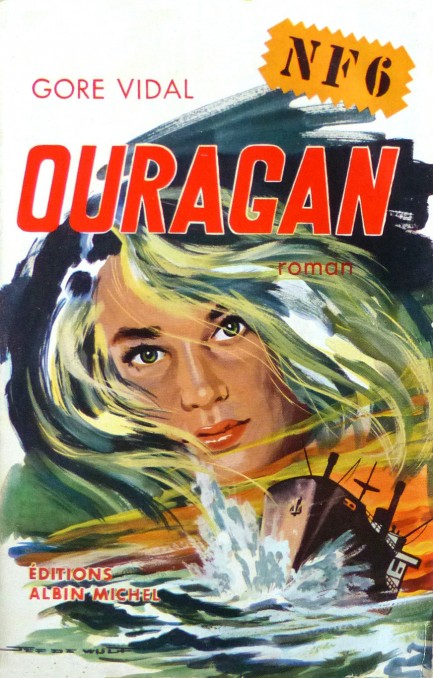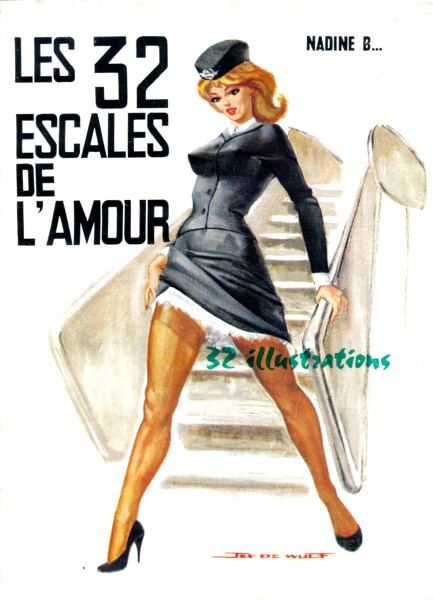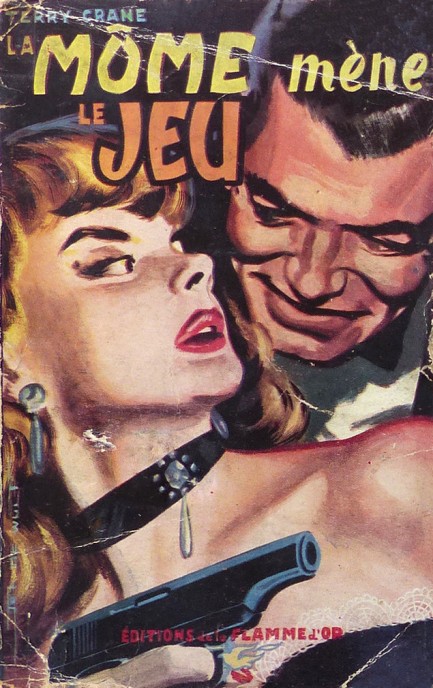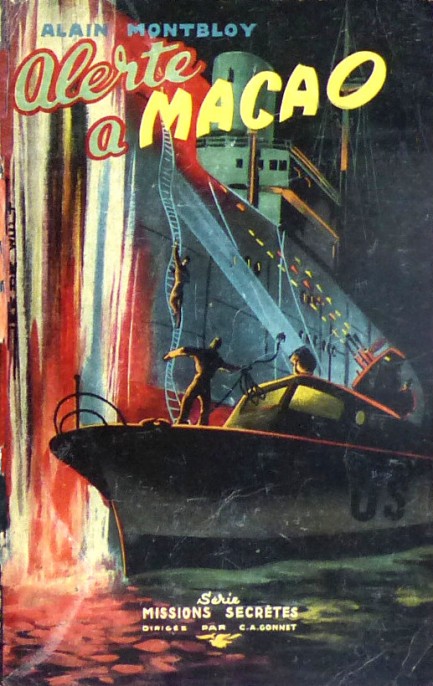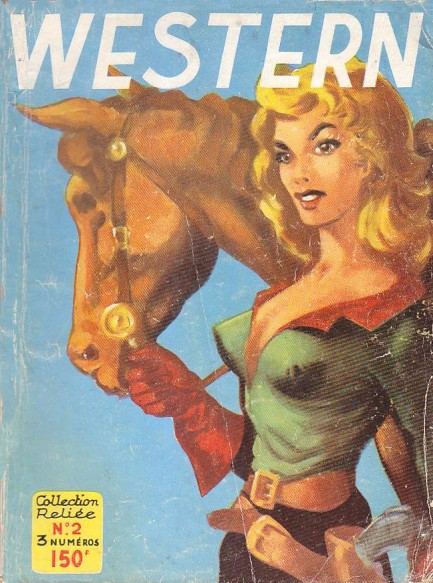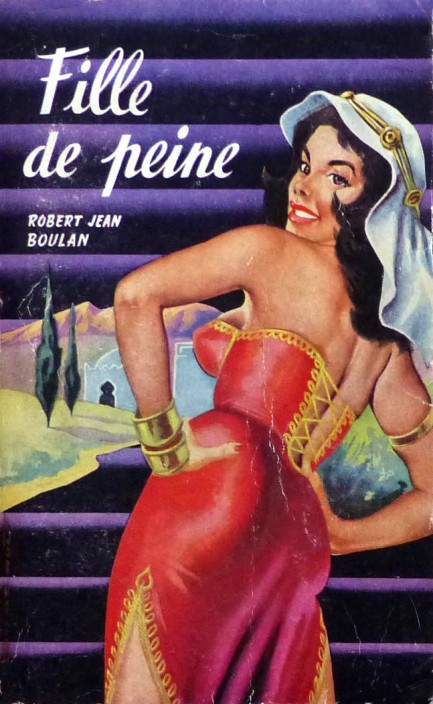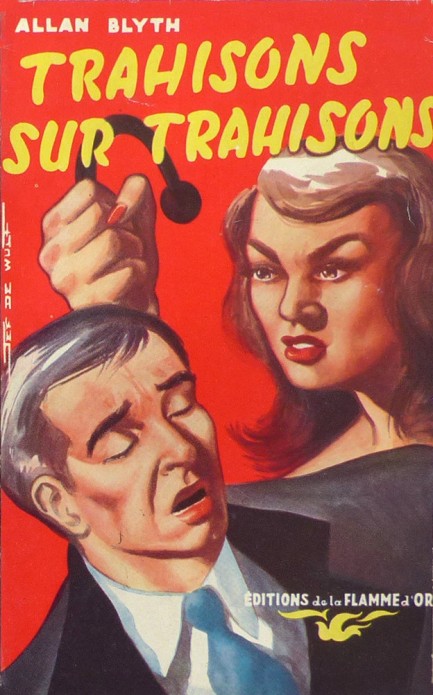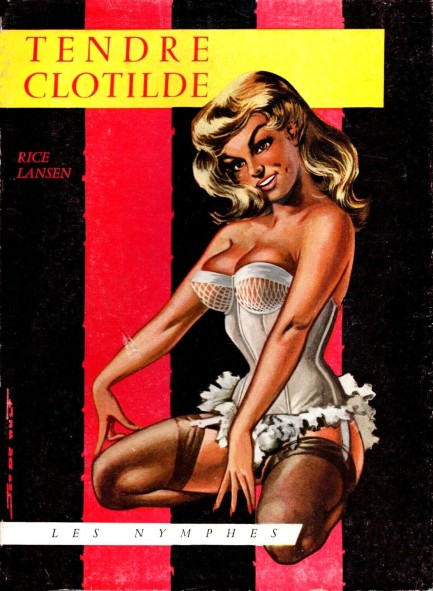 De Wulf makes space among French paperback artists. 
This is a nice cover for 1957's Lucile et la volupté, by Albrecht Jhonn for Les Presses de la Nuit. The woman here holding a paint brush against a blank white background looks rendered in mostly colored pencils, with a watercolor assist in the hair. We like the suggestion that she painted the author's name, but the signature that matters here is that of prolific cover artist Jef de Wulf, who signed this mostly empty piece on the lefthand edge. He and certain other French illustrators worked in a simple style compared to most of the names in U.S. paperback art, but there's a breeziness to their output that we enjoy. Obviously, French illustrators like Aslan, Jean David, René Caillé, and others are comparable to anyone, and their highly accomplished art is collectible, but French publishers were also willing to embrace this sort of sparse, spacious visual style.
 She's so ready even the book cover is moist. 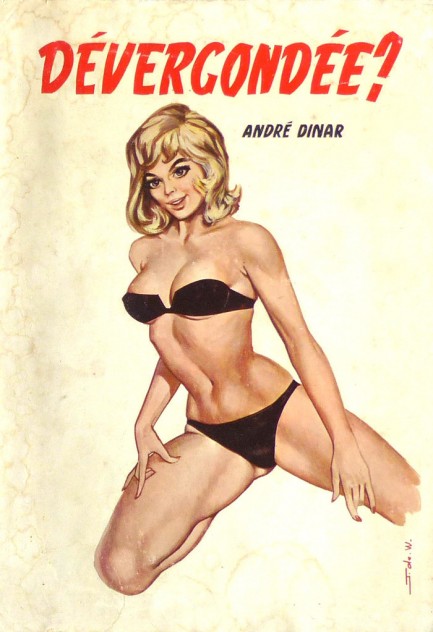
Above: a simple but striking piece of dust jacket art by French illustrator Jef de Wulf we found on an auction site for André Dinar's, aka, Georges-André Delpeuch's 1968 novel Dévergondée, a title that translates literally as “wanton.” Obviously, the paper got damp at some point, and being us, we ran with that idea for our subhead, and being them, the Pulp Intl. girlfriends told us we're gross. But that's the pulp life. You just gotta roll.
 Formal occasions in Mogadishu are murder. 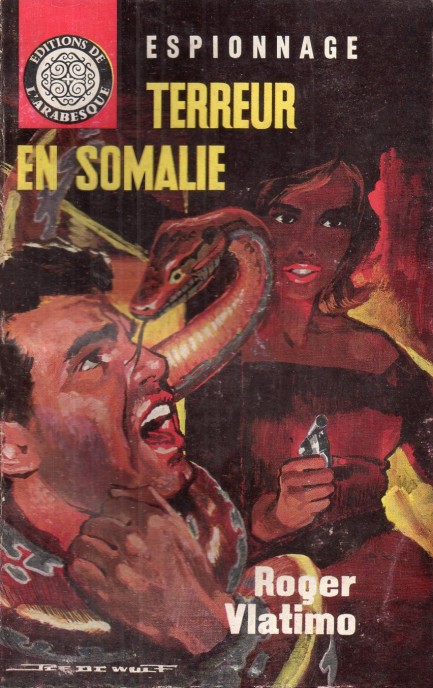
Jef de Wulf works in a somewhat different mode with this cover illustration for Roger Vlatimo's, née Roger Vilatimo's 1963 spy novel Terreur en Somalie. His art is usually quite spare, often with a lot of negative space, but here he's produced something chaotic that fills the frame and draws the eye to various elements—gun, lipstick, a splash of color that gives the impression of flames, and of course the snake. The contrast with his work at its cleanest is stark. Look here or here to see what we mean.
Vlatimo wrote a stack of spy capers set in exotic places like Morocco, Iran, Turkey, and Vietnam. He also wrote a series as Youcef Khader, and those all starred a franchise character, Algerian special agent Mourad Saber. Additionally, Vlatimo wrote as Jean Lafay, Tim Oger, Roger Vlim, and Gil Darcy, which was a pseudonym invented by Georges J. Arnaud and used by several authors. Vlatimo's books were quite popular and some are even available today as e-books, which is the surest sign of success we can imagine. Vlatimo, though, died back in 1980.
 A dozen reasons to love French cover art.
We've done plenty on illustrator Jef de Wulf. Today we have a diverse collection of more of his work. As always, we'll circle back to him later. In the meantime, we recommend looking here, here, here, here, and here.
 We just can't say no—to René Roques. 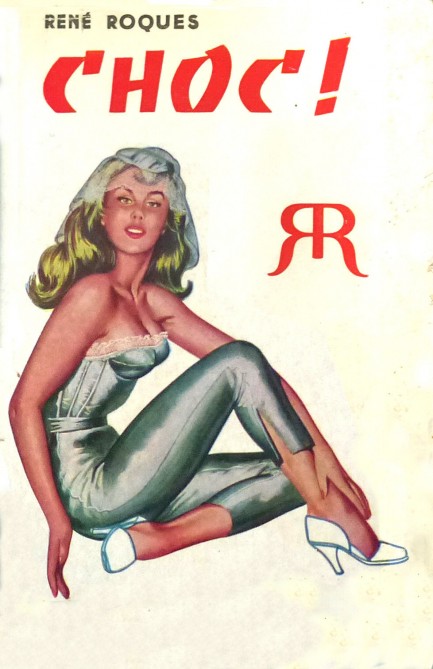
Once again we're charting the output of Éditions R.R. and René Roques. This cover for the novel Choc!, or “Shock!, was painted by Jef de Wulf. Click the keywords “Éditions R.R.” below and you can see four more excellent fronts.
 What do you mean my squirming is throwing off your aim? Screw you! I hate this idea! When do we switch places? 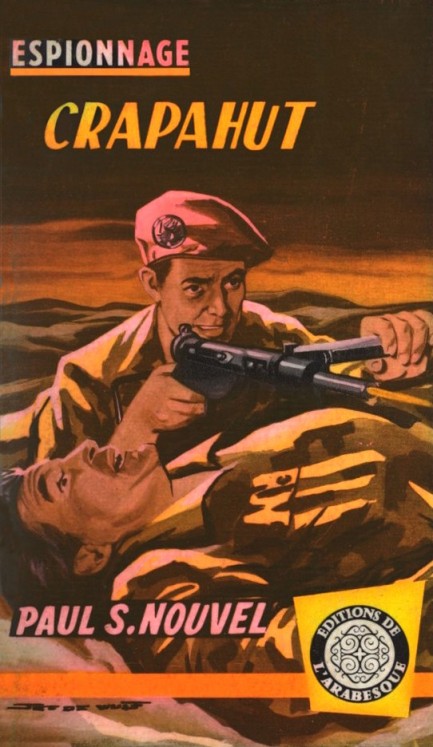 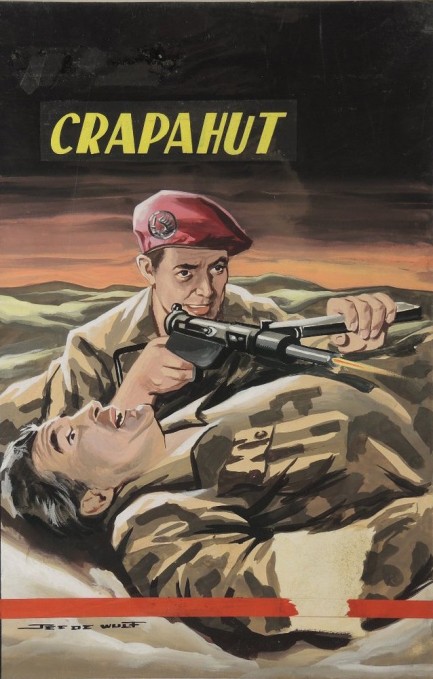
French illustrator Jef de Wulf painted so many covers for Editions de l'Arabesque that he was almost an in-house employee, and here we see him again on the art chores for Paul S. Nouvel's 1960 thriller Crapahut. You also see the original art, and can see the hole left for the publisher's logo, because why waste paint when you don't have to? Crapahut, of course, translates into English as “outhouse.” Actually, that's not correct. We don't know what crapahut means. We think it's a place. A place you can smell from miles away. Update: We got two answers on this, the first from Jo:
About the book named Crapahut, I can tell you it's a soldier's training, very hard and difficult. It's a slang word used first by military people (warrior's path?). You can use it also to speak about a long and difficult hiking in the mountains without any military sense. The second answer came from Jean-Marie: «Crapahut» from military slang, we have the verb «crapahuter» that means: walk, during war or battle if possible… with haversack very heavy, with arms, with enemy all around, into jungle, for 5, 10, 20 kilometers. Very hard. «Ha! qu’est-ce qu’on a crapahuté avant d’arriver à Danang,,, »
Thanks, Jo and Jean-Marie. Another mystery solved.
 I won! I knew I would once they restricted track and field to beautiful French actresses! Eat my dust Anouk Aimée! 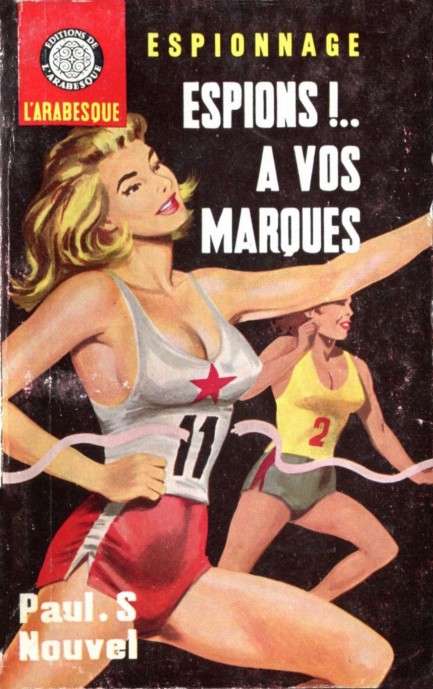
Catherine Deneuve absolutely flew in this race. It wasn't nearly as close as the art makes it look. Espions!.. à vos marques was written by Paul S. Nouvel, aka Jean-Michel Sorel, and published in 1964 by Éditions de l'Araesque. The cover is unsigned, but it's probably by Jef de Wulf. If we get more info we'll update this. We can't wait for the triple jump. Hopefully, Catherine will win that too.
 The best hired guns never miss the mark. 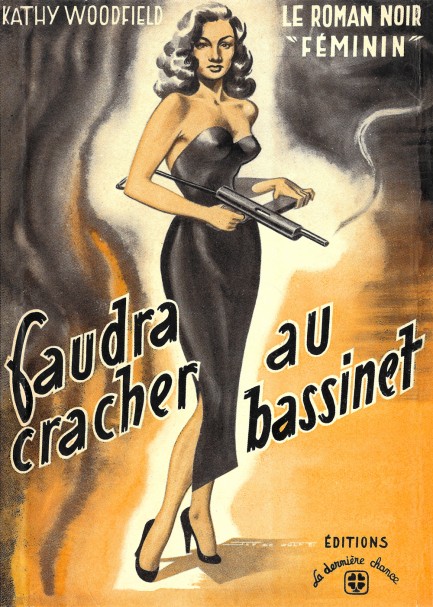
Like clockwork, it's time once more for Jef de Wulf, one of the most reliable paperback illustrators of the mid-century era. Every cover he painted, for whatever company employed him, was stylish and unique. He was automatic. Here's an example of him at his best on this 1952 cover for Faudra cracher au bassinet, by André Helena writing as Kathy Woodfield, for Éditions la Dernière Chance's series Le Roman Noir Féminin. We don't know anything else about the novel except that the title translates as “you'll have to spit in the bassinet,” which is French slang meaning to give reluctantly. It only makes sense once you know that “bassinet” doesn't just mean a baby's bed, as it does in English, but also a church collection dish. Eew. We give unreluctantly more de Wulf here, here, and here.
 No secrets here—de Wulf is de best. 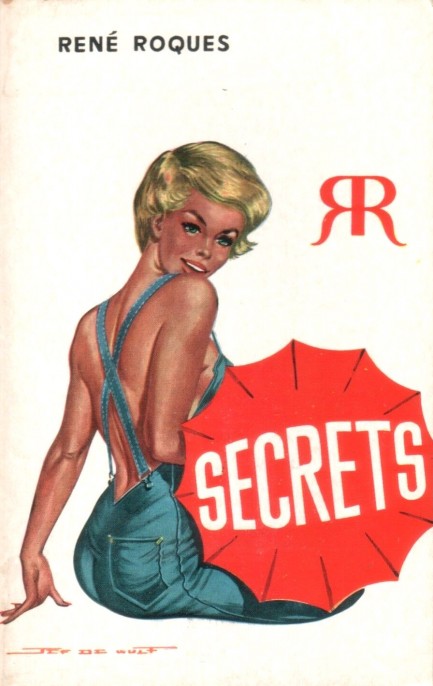
Above is a cover from French publisher Éditions R.R., for Secrets, by author René Roques. Easiest way to get published: own the publishing company. We discuss that and other things about Roques in a bit more detail at this link. The art here is by Jef de Wulf, whose work we've shared numerous times. We love him. There's a lightness and ease to his pieces that few paperback artists achieve. We'll have more from him later.
 Who needs a man when you have technology? 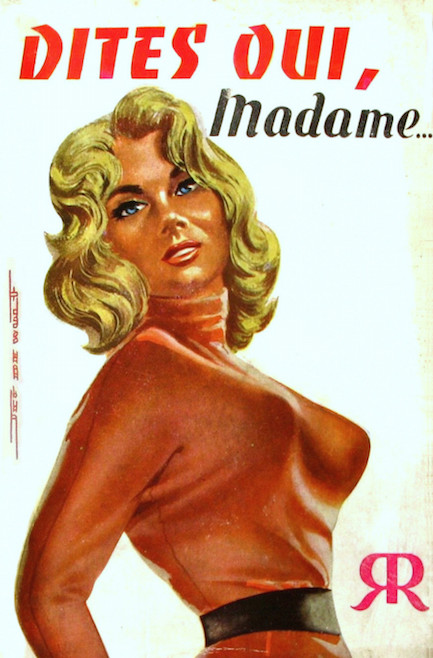
Éditions R.R. specialized in beautiful covers, and this one continues the trend. The art is by Jef de Wulf, and it fronts Dit oui, Madame by René Roques. You can't tell, but this is about a woman who falls in love with a robot. And he's a French robot, so he shares his feelings, which is more than you do. Roques actually got racy enough here that the book was banned shortly after publication in 1957. Still, we bet it wasn't as wild as this mechanical lover novel. Or for that matter this one. They say robots are going to take all our jobs. Add sex to the list.

|
 |

The headlines that mattered yesteryear.
1945—Churchill Given the Sack
In spite of admiring Winston Churchill as a great wartime leader, Britons elect
Clement Attlee the nation's new prime minister in a sweeping victory for the Labour Party over the Conservatives. 1952—Evita Peron Dies
Eva Duarte de Peron, aka Evita, wife of the president of the Argentine Republic, dies from cancer at age 33. Evita had brought the working classes into a position of political power never witnessed before, but was hated by the nation's powerful military class. She is lain to rest in Milan, Italy in a secret grave under a nun's name, but is eventually returned to Argentina for reburial beside her husband in 1974. 1943—Mussolini Calls It Quits
Italian dictator Benito Mussolini steps down as head of the armed forces and the government. It soon becomes clear that Il Duce did not relinquish power voluntarily, but was forced to resign after former Fascist colleagues turned against him. He is later installed by Germany as leader of the Italian Social Republic in the north of the country, but is killed by partisans in 1945. 1915—Ship Capsizes on Lake Michigan
During an outing arranged by Western Electric Co. for its employees and their families, the passenger ship Eastland capsizes in Lake Michigan due to unequal weight distribution. 844 people die, including all the members of 22 different families. 1980—Peter Sellers Dies
British movie star Peter Sellers, whose roles in Dr. Strangelove, Being There and the Pink Panther films established him as the greatest comedic actor of his generation, dies of a heart attack at age fifty-four.
|

|
|

It's easy. We have an uploader that makes it a snap. Use it to submit your art, text, header, and subhead. Your post can be funny, serious, or anything in between, as long as it's vintage pulp. You'll get a byline and experience the fleeting pride of free authorship. We'll edit your post for typos, but the rest is up to you. Click here to give us your best shot.

|
|







